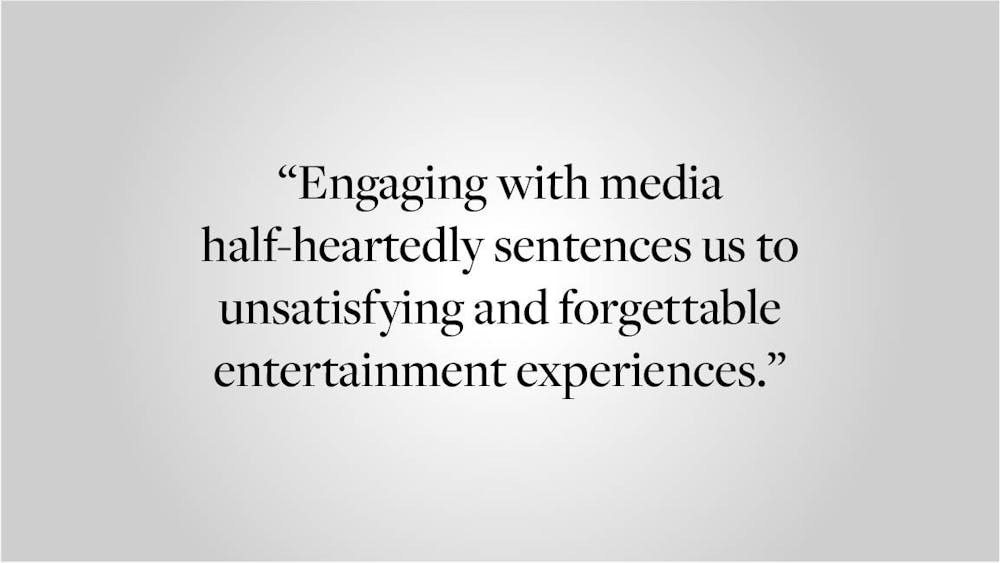On a trip home this weekend, I — for the first time in a long time — found myself sitting down to watch something on an actual television screen. I had never seriously considered buying a TV for college, but it was jarring to me how little I noticed the absence of one. I initially thought to attribute this to my busy university schedule or new hobbies, but I consume more media than ever. I may no longer rely on a classic television set, but the podcasts I listen to on the way to class, the Netflix original shows I watch on my phone during study breaks and the TikToks I scroll through before bed are ready substitutes.
Cable TV and older forms of entertainment have quietly given way to streaming and social media. Although tech-fueled changes in our media consumption patterns may seem innocuous or even helpful, entertainment’s easy accessibility and greater integration into our lives saps the meaning it once had for us.
Cable TV hasn’t become entirely passé as of yet, but it is safe to say that it is on the decline. With the explosion of broadband (meaning new compression techniques and an increase in available bandwidths) in the early 2000s, at-home internet became relatively common. Video streaming became a viable service to sell to households. While criticisms about cable have always existed, there wasn’t always an alternative way to relay high-quality video at a reasonable speed before broadband.
But today, broadband technology has more than taken off. When I think of media entertainment, what comes to mind are popular video sharing social media apps as well as on-demand streaming services that provide comparable content to cable. In fact, since 2015, the percentage of Americans who use cable or satellite to watch TV has dropped 20 points, from 76% to 56%, a decrease which was especially pronounced among adults under 50. By contrast, streaming services saw a significant uptick during the same period, and social media applications seem to have emerged as a major entertainment medium for Gen Z.
I grew up loyally following my favorite cable TV shows on a weekly basis for entertainment. Even so, the transition to spending hours on my Instagram “Explore” page, binging entire series on Disney+ and following my favorite YouTube creators has felt relatively seamless. After all, these options are easier and more flexible than older entertainment mediums, as you can stream your favorite content whenever and wherever you like. However, the more immersed I get into social media and streaming services, the more I feel like that overwhelming convenience takes something away from the entertainment experience I once had.
I’ve found that entertainment always being an arm’s length away makes it numbing. We end up taking it for granted. Sometimes, I find myself playing TV shows in the background while I do mundane tasks, just to fill the silence. I’ll watch every YouTube video some influencer has posted one day and not remember their name the next. And who hasn’t spent hours on their “For You” page only to be unable to later recall a single TikTok they watched?
These are signs of us unintentionally devaluing the media we consume. This hurts not only those who are creating it, but also ourselves — entertainment is supposed to make us happy, and if we inhibit our ability to appreciate it, we are missing out. As Malena Colon ’24 suggested in her Feb. 18 piece in post- Magazine, we once cherished our media more because we had the supposed inconvenience of having to anticipate each installment in a show.
Streaming services seem to agree with this assessment, at least to some degree. After a rise in shows being consumed in full-season installments several years ago, many streaming platforms are reverting back to a weekly release schedule for some shows. And from Disney+’s “WandaVision” to Showtime’s “Yellowjackets” to HBOMax’s “Euphoria,” there’s no shortage of shows generating online buzz while they’re airing. In my personal experience, developing that ritual of dedicating a specific time and day to a particular show makes you even more attached to it.
If streaming services can pick up on the increased engagement we have with media when we are intentional about it, it seems that we should be able to apply the same intentionality to the rest of the media we consume. Whether it’s a new TV show obsession or the cornucopia of content that is TikTok, this means being mindful about connecting with our chosen forms of entertainment – from selecting them to taking pleasure in them to even retaining ideas they left us with. Engaging with media half-heartedly only sentences us to unsatisfying and forgettable entertainment experiences. This behavior isn’t inherently wrong, but we shouldn’t prevent ourselves from getting as much joy out of entertainment as we can. At the end of the day, even if technology enables us to access media conveniently, it means nothing if we end up enjoying it less.
Anika Bahl ’24 can be reached at anika_bahl@brown.edu. Please send responses to this opinion to letters@browndailyherald.com and other op-eds to opinions@browndailyherald.com.





